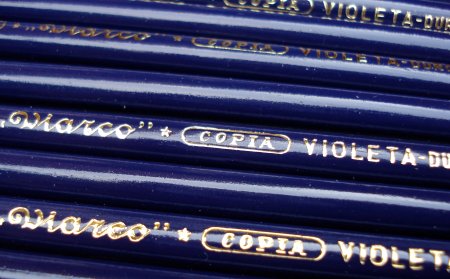
The copying pencil was once a mainstream technology.
A precursor to carbon paper, the Gestetner machine, and the photo copier, the copying pencil allowed the duplication of hand created documents.
In today’s electronic era, the capture and duplication of most analogue input is a relative triviality. Hand copying a hand created document is done only in unusual circumstances. Ancient manuscripts in archives that might be damaged by a scanner’s lamp will be transcribed by scholars. Ceremonial invitations may be handwritten (sometimes in calligraphic script, equally removed from modern practice). But the norm is to digitize (scan, photograph, or photocopy, and possibly further electronically process) documents whose origins are analogue if a copy is required.
Of course, hand written original documents will be less common today, with document creation being partially or wholly electronic in modern offices and schools.
The copying pencil is a bridge between the modern era and the period when copying was not possible. It allows for a single, imperfect, fragile copy (typically on tissue paper) to be taken.
Though once manufactured in quantities of millions, there is relatively little information about how they were used, or how one would use those in current production.
There are four main sources I have been able to consult.
An often cited article, The Copying Pencil: Composition, History, and Conservation Implications by Liz Dube of the University of Notre Dame offers a great overview.
This article reveals that documents written in copying pencil once had presses with damp tissue paper applied, creating copies of correspondence that would placed in letter copying books. The copying pencil contains a dye that is released by moisture.
The article goes well back into the 19th century, and does provoke questions about what modern copying pencils are for. All but one of the pencils in Dube’s article appeared (even with magnification aids) to the author to be a regular graphite pencils.
The one that was not graphite-like was deemed to be a “hectographic” pencil. (And most of today’s copying pencils don’t appear to be graphite-like.)
This Wikipedia article mentions their use in tattoo layout. I have a couple of vintage hectographic pencils, and in searching online for modern ones, I’ve tended to come across websites that have confused the terms “hectographic” with “hexagonal”. They are not the same.
I did come across a tattoo supply company that offers their own brand of hectographic pencil.
The magic of purple pencil by Gajendra Rawat at the Australian War Memorial has further information, and a pretty good example of making a copy – the copy is easily readable.
Henry Petroski’s “The Pencil” only briefly mentions this pencil type.
Pencils mentions that in Italy, copying pencils are used for ballot marking during elections. I am not sure if this is still the case, but it is helpful as a modern usage description.
So I returned for another look at the Noblot, as well as some other modern copying pencils.
I had been trying to use the Noblot more like a watercolour pencil, laying down a line and then applying a brush. (Forgive me, it didn’t come with a manual!) but applying a damp piece of paper to the original produced much better results.


With tissue paper, I realized something else – the paper being see-through, you don’t have to be a mirror-reading expert – just read the copied document from the other side.

This won’t be perfect for copying detailed small writing, but it certainly is nonetheless amazing to find that these pencils have this embedded copying capability.
The official product page doesn’t mention their use, but art supply store Dick Blick says they can be used for assistance in sign restoration and painting.
Next, I tried Lyra’s offering, the Lyrato. Offered in red, green, and blue, I have only the latter two versions. They visually appear to be green and blue colour pencils. Attempting a copy reveals a small secret – the dye colour doesn’t necessarily correspond to the lead colour. Both green and blue pencils reveal the same blue dye! I am now very curious about their red pencil.

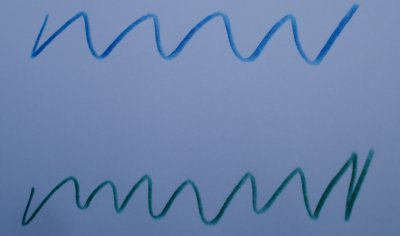
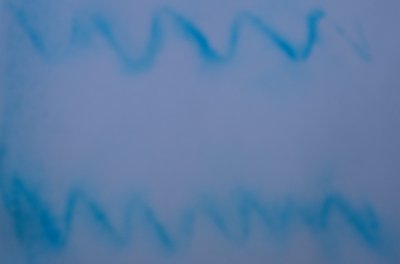
Lyra also has some intriguing offerings in their catalogue, such a copying carpenter’s pencil.
Next, Veritas. Veritas is a brand of Lee Valley Tools, and I am curious about who manufactures these pencils. Lee Valley also sell branded graphite pencils, made in England, while these pencils are marked “Made in USA”.
The Veritas Indelible, like the Noblot, appears to be a regular graphite pencil, so it is the second such modern pencil that I am aware of. It leaves a much richer, darker mark than the Noblot, and has a puple dye. The Veritas Indelible Red is, you guessed it, red with red dye.

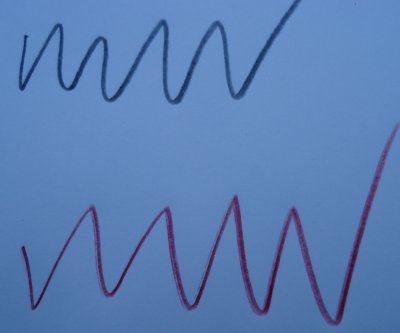
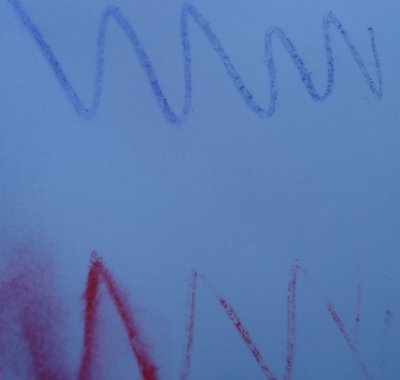
Lee Valley is very clear about what these pencils are for – marking wood with a scriber.
The deluxe copying pencil is the Castell Document from Faber-Castell. It comes in four colours – black, green, red, and blue. The black is like a black pencil crayon, not a graphite pencil.

The black pencil has a most interesting model number, 9100 1/2. I love that “1/2” ! It evokes some of the tradition behind these pencils.

These pencils have the richest colours of this set, both as pencils and dyes.
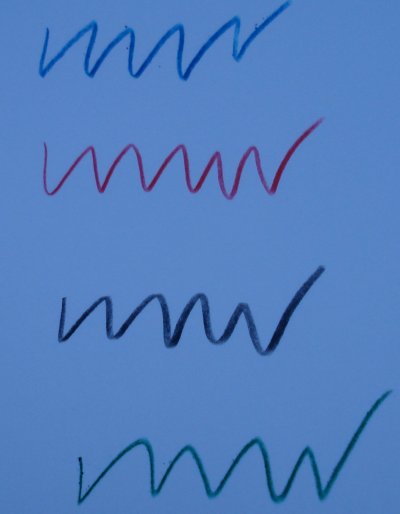
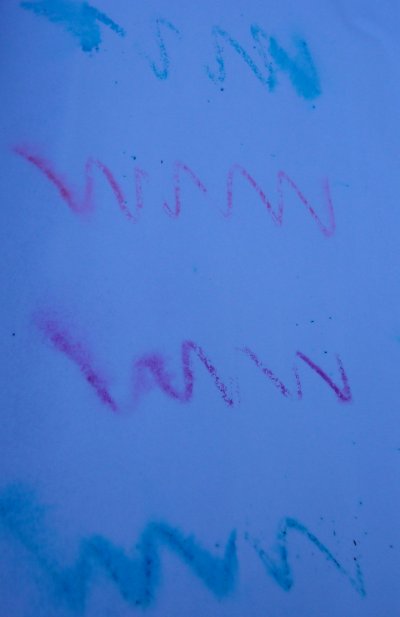
Like the Lyra, what you see is not what you get. The blue pencil has a blue dye, and the red pencil has a red dye. But the black pencil has a purple dye, and the green pencil has the same blue dye as the blue pencil.
Faber-Castell says they are “for cheques, deeds, contracts etc.” Basically, use as an indelible pencil. Hmm, I am skeptical. Why four colours? I don’t think I can even imagine what would ensue if I brought one of these pencils to a bank or lawyer’s office to sign an official document, and I doubt deed signing is the current market.
Finally, Portuguese manufacturer Viarco offers the 272D Copia Violeta. It distinguishes itself with a purple lead. While purple dye may be a standard, the matching lead, dye and rich purple pencil finish create a great thematic unity. Viarco manufactures a full line of pencils, including this gem, with a staff of just over two dozen! That said, it makes a fairly faint line to my eye.
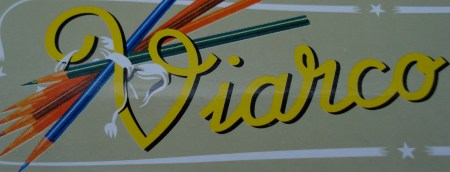
Let’s summarize these modern copying pencils:
| Manufacturer | Model | Lead Colour | Dye Colour |
| Faber Castell | Castell Document 9100 1/2 | Black | Purple |
| Faber Castell | Castell Document 9609 | Red | Red |
| Faber Castell | Castell Document 9610 | Blue | Blue |
| Faber Castell | Castell Document 9611 | Green | Blue |
| Lyra | Lyrato 778B | Blue | Blue |
| Lyra | Lyrato 778G | Green | Blue |
| Lyra | Lyrato 778R | Red | Red? |
| Sanford | Noblot Ink Pencil 705 | Graphite | Purple |
| Veritas | Indelible | Graphite | Purple |
| Veritas | Indelible Red | Red | Red |
| Viarco | Copia Violeta 272D | Purple | Purple |
We’ve seen these modern uses proposed:
I accept “sign painting aid” and “scribing tool” as legitimate uses, though the markets for these purposes must be quite limited. I can’t confirm the election ballot situation, though it would represent a solid but irregular business. And wouldn’t Italy source these pencils from Fila rather than buy any of the pencils named here? Perhaps other countries use the same method.
Regarding the traditional uses as suggested by Faber-Castell – I already mentioned my skepticism here. Ink is not exactly unestablished as a legal marking medium. Or is there some official use I’m not contemplating? Don’t forget the Dube article, which shows this medium does not do well at surviving humidity or moisture. It would seem to be a very unusual choice for official documents.
Tattooing I also accept as a modern use, and wonder if some of the multiple colour pencils might be useful for that task.
Since it isn’t known what sort of market share these pencils have, it may be that the cited uses are in fact correct.
Are there any other uses for these pencils that you are aware of? Or any other manufacturers still making them?

Although not written in pencil the copy of the United States Declaration of Independence was submitted to such a process. The paper was dampened and the ink was transferred to a copper plate from which a copies was printed in 1823. This partially explains why it’s so faded, when you look at it in the Archives. I remember this story from a visit to the Archives and Wikipedia affirms it.
Wow, very interesting post, I wasn’t aware of any of that!
That’s a cool story about the Declaration. Maybe these pencils are still used in printmaking? It seems like a waxier pencil would be more useful in lithography, but what do I know? Plus there’s scads of other printmaking methods out there, obviously.
as far as i recall (speaking of the italian ballot marking use) the use of the copying pencils in Italian election dates back to the first post-WWII ballot (the ballot between monarchy and republic we had in 1946): because of the low diffusion of pens the government decided to use copying pencils (for them indelible mark). since then the law has never been changed, and still today we vote with pencils.
nowadays the pencils are made for the goverment by an unknown (well, one that i don’t know) company, and are quite anonymous, with only the “government” mark.
btw, i never moisten the point of the pencil befor marking the ballot (and i think noone does it), so i guess there’s no point in using a coping pencil…
Please be careful with copying pencils! The used colours are (more or
less) poisonous.
The poison central of Bonn’s university clinic warns that even blown away
sharpening dust may lead to eye damage.
http://www.meb.uni-bonn.de/giftzentrale/slexikon/kopierst.html
(Alas, only in german)
The pencils can be sharpened to a very fine point which at
the same time is brittle so parts of the lead can enter a wound resulting in
poisoning and tissue damage. Very good article at Wikipedia
http://de.wikipedia.org/wiki/Kopierstift
(Need I mention: only in german?)
The use of a protective cap is advisable and copying pencils should
be kept away from children.
There’s also a hint about the colours: In german offices
the simple clerk signed in blue (blue being the prevalent colour
for fountain and ballpoint pen in in Germany), the head of dept. or
director in red and the general manager in green. This colour
code is still used in many govt. offices in Germany today.
My thanks for this excellent additional information. I can confirm that copying pencils are at least a potential household hazard – the pencil shaving residue does have dye, and will get all over the place if care isn’t taken.
Adrian – The role of these colours in German offices was unknown to me. Thank you for sharing this!
A footnote – the wikipedia article has a link to a substantial academic paper (German language) that I was not previously aware of. The paper can be found here. (PDF format)
I really enjoyed this this posting, and the very interesting and informative comments from Geo B, Memex and Adrian. I guess it’s the moron in me, but there is something about these copying pencils that fascinates me, and that I “just don’t get”.
When I was a child in the 1950s, I got a hectographic copier as a present. It was essentially a shallow metal box of gelatin the size of a sheet of typing paper. You wrote on the paper with a special purple pencil or ink and if you laid it on the gelatin, you would leave an impression, from which you could make copies. This was before xerox was commonly available. I also sent away a coupon from the back of a cereal box and got a smaller version (2 ” X 3″) with colors.
I have a indellible pencil that is patent dated 1867 and has its complete paper lable on it by The Indelible Pencil Company, Northampton, Mass. Can anyone email me and tell me about it? manylittle@aol.com
While looking to purchase 10000 copy pencils (indellible. aniline etc) I came across your article. I have used copy pencils the last 30 years.
(I got your attention) In the manufacturing of prostheses and orthoses, a plaster of paris (negative) mould is made from a limb, that is filled with plaster slurry to create the (positive) cast. In order to transfer the position of boney points to the mould (negative) and later on the cast (positive) the copy pencils are used.
I look for cheap ones with our name on it to donate to the prosthetic projects we support around the world and the supplier I had before (hindustan pencils) now only sells their own brand.
Thanks for the info on your article
Peter
Any tip where to buy????
We are located in C-America
Regards
Peter
And Jolly from Austria, Koh-I-Nor and Staedler made them also since I have a few.
The ones from hindustan pencils are branded Apsara
Bye
Interesting post. I came across your site after doing a search for this pencil I just found around the house. I reads “Carlisle’s Indelible Election Pencil”. It seems to be the same as a copying pencil as it turns blue when moistened and is really hard to erase.
Dear Sorry no english interested hectograph pencils violet
thanks
manuela for spain
The tattoo industry worldwide uses the purple ink copy pencil for stencil transfers. As these pencils are becoming a dying breed, it is becoming more difficult to find them for our industry. We need them but the manufacturers do not take that into consideration to continue manufacturing them. I’m researching them to purchase too. Let me know if you’re selling!
Hi Eagle,
Do you have an industry association that could make this need known to pencil manufacturers? I’m sure some of them would love the business. I’m trying to think of who makes the traditional purple copying pencil in 2010. Viarco does look like best source for purple, unless you can use another colour. They have a website here and are very responsive to enquiries in my experience.
Hi! Thanks for an interesting post.
I work as an prosthetist/orthotist and, even if CAD/CAM is well on its way, it is still common practice to use plaster bandages to make a negative model of a patient’s limb or amputation stump. The negative cast is then poured with plaster to create a positive model of the arm/leg/stump, which is then used for manufacturing the device. I have used the purple indelible pencil to mark areas of interest, i. e. bony prominences, on the patient, these markings will appear on the inside of the negative cast and then transfer as easily to the positive plaster model in order to make the rectification of the plaster more correct.
We’ve tried several types of pencils over the years, but it is really only the purple ones that give satisfactory results. And at least in Sweden, they are almost impossible to come by these days. I will check out Viarco. Thanks!
Sorry – I completely missed Peter’s comment of jan. 2009. Still a lot of interesting facts in your post, though.
Erling, thanks for your comments.
This type of pencil seems important to a number of professions. I think I should forward some of this input on to the pencil industry.
To the best of my knowledge, no Japanese or North American manufacturer makes this variety. Nor do Derwent, Staedtler, Bic, Faber-Castell, Lyra, Koh-I-Noor, or Stabilo. (Lyra does make a carpenter copying pencil.) There are still a number of smaller manufacturers in Europe that I’m not familiar with – they might be possibilities. But Viarco for sure still makes the “272D Copia Violeta” in Portugal. India I am even less familiar with – but Peter mentions a version made by Hindustan Pencil Co. as well.
Are copying pencil similar to hectograph pencils, can it be used for making tattoo stencils?
I was reading the post fro Erling Larsson in Sweden. We are an orthotic laboratory and have used the No-Blot indelible pencils for over 40 years. Because we are a custom orthotic laboratory we need these to write on our positive plaster casts. Nothing else really works as well! Now we are not able to get them, in fact we have bought up all that we can find! We have been testing, testing and testing. The closest we have come so far to finding something comparable to the No-Blot is the Veritas Purple Indelible pencil. After doing all the research that I have, I find it strange that these are so hard to get. Obviously there is still a demand for them! I guess the demand for them just isn’t big enough! Thanks.
Since my previous comments, I’ve bought these:
http://cgi.ebay.com/1-DOZEN-HECTOGRAPH-PENCILS-TATTOO-FLASH-TRANSFER-COPY-/280530077480?cmd=ViewItem&pt=LH_DefaultDomain_0&hash=item4150e54728
For the orthotic/prosthetic profession they work great! The brand is Spaulding & Rogers #5005.
We have several boxes of semi-indelible copying pencils. If you would like a sample then simply contact us and provide us with your full name and address (including country).
E-mail info@natt.co.uk
we use the veritas to mark casting rings while they are moist. The rings are made of a poured investment material placed in a kiln. The marks hold up becaise, IMO, it soaks into the investment and remains after burnout. we also use a waxy lump of dark polish but the pencil is much cleaner!
I was given today a box of koh-I-nor copying
Pencils, all pencils were in the box unused, they
Are 73b hard, called “mephisto”, would anybody
Possibly know anything about these. they say
Made in czeckoslovakia.
Hi Dennis, these were made in Czechoslovakia by a company Koh-i-Noor… Great pencils. This company still exists btw http://www.koh-i-noor.cz/en/uvod
I haven’t read all these posts, but I was looking for information on hectograph pencils still available for purchase. Such pencils were used by my grandmother, a Canadian prairie teacher in the 1930’s or ’40’s (?) to create the original document for the hectograph gel “jelly pad” reproduction production of multiple of tests for her students. One moistens the surface of the gel (her tablet was hinged and had two flat pans of gel), lays the original (written with hectograph ink (straight pen) or pencil, peels off the original, and approximately 20 copies could be made (of decreasing intensity of colour.)
For what it is worth; as a child in the 1950s we often had these pencils, perhaps it was austerity so nothing was thrown away, and they were called “copyink pencils”. It may well have been a hearing mispronunciation; or perhaps all of yours are?
They were exclusively plain wood and purple lead when moistened. We only used them for colouring in pictures or the back of your hand if licked. Perhaps they had a war use and that’s why they were common afterwards. I never owned nor saw one longer than 4 inches/100mm but that may be austerity again.
Thanks for the memories
Cumberland copying pencils were used in the 1950’s to mark washing sent to a laundry (few washing machines were available) – to aid identification. I also know these pencils were used in paper mill laboratories to mark samples (e.g. Davidsons in Aberdeen in the 80’s). They would also be useful to mark filter paper used in other labs.
I have one, normal 7inches long size, natural wood, marked ‘Eagle Pencil Co “Utility Copying” Made in England’. We had several around the house when I was a child in Hertfordshire, England, in the early 50’s, when I had to be stopped from licking them and getting a purple tongue. I believe in different areas some were issued to the Home Guard – of which my father was a member. But that may not have been the origin of the one I have.
Many thanks for all the info shared here. I have had three books on calligraphy published and I’m just writing a sample chapter on ‘A Celebration of Small Things’ and checking my facts to enable me to include a picture and some details, if a publisher is interested in a new book.
Best wishes to all from Australia
I’ve just been examining a pencil lead holder made by Perry and Co. A museum site says 1850’s to 1880’s – but the interesting thing to me is that it has ‘Solid Ink’ embossed into the lid. Could the leads have been of the ‘copying pencil’ nature? I have one of these small tins, but the enclosed leads seem normal.
http://museumvictoria.com.au/collections/items/414714/pencil-lead-holder-perry-co-circa-1850s-1880s
Shrunk ebay linki for a picture of the lid: http://tinyurl.com/alycw2p
I have used copying pencils purchased in the early 90s for carpentry (they are Turkish – name ADEL). Either scribing round timber connections or when repairing old timber frame houses. The activation by moisture of the dye allows very light contact by the marking pencil, this is useful for long scribes of adjoining timbers in awkward places (log buildings or in situ repairs) and also when working outdoors on wet wood. I heard that they may be poisonous hence rarely use nowadays! when not wet seem to be like ordinary pencils hb perhaps but purple when wetted.
As a plaster mould maker and modeller it is well known that the copying pencil is the best pencil for drawing on damp plaster of Paris. My rare ‘Puma’ copying pencil by The Cumberland Pencil Co. like time, is fast running out.
Phil Read
I can add another use for indelible pencils that has not yet been mentioned: dahlia tubers (the root-like objects from which dahlia plants grow.) Between the time they are dug from the ground (usually in the fall) and a clump is divided into individual tubers to make new plants, until the time they are replanted in the spring, the different varieties of dahlia tubers have to be labeled to keep them straight. (Especially important when tubers are exchanged among dahlia growers.) The most effective method was always to mark the varietal name on each tuber with an indelible pencil (traditionally a Sanford “bottle of ink in a pencil”). These (and most of the satisfactory equivalents) have been phased out over time (due to liability issues, I believe, as they have some level of toxicity.) I have used such pencils in this way for forty years, but I am down to my very last one (which is marked “Carlisle’s indelible election pencil”.) I have been unable to find a satisfactory substitute and would welcome input from anyone who knows of a suitable alternative and where to buy it. The reasons why indelible pencils are ideal for this task include the following: 1) the surface of the tuber is somewhat rough, but it is easily scratched through so that it either a) can’t be written on using pens, grease pencils, other kinds of pencils, crayons, magic markers (i.e., alcohol-based, like Sharpies), and everything else I have tried; or b) it damages the surface and becomes illegible or does harm to the tuber. 2) If one dampens the surface of the tuber with a sponge, the old indelible pencils would soften slightly and therefore write smoothly and semi-permanently onto the tuber without damaging the surface. 3) Once the tuber was labeled, the writing remained in place semi-permanently — to the point where it was not uncommon, when you dug up the tuber after it had been buried in the ground for an entire growing season and despite, watered every couple of days, for the varietal name to be still quite legible. I realize that this application may not be commonplace, but there are any number of dahlia growers across the country searching for a present-day equivalent, so far without much success. Please let me know if anyone has a source of pencils that can do this job.
Addendum to my previous comment: the problem with all of the alternative pencils I have tried (including some of those mentioned in previous posts) is that the ink blurs too much. That is, when a varietal name is written on a tuber, moisture causes it to blur to the point where it becomes unreadable. This was never a problem with the old-style pencils, but it seems to be fairly consistent with those being sold at present.
Just following all the posts after an interesting reference to the “copying-ink pencil “ in HG Wells’ novel titled “The first men in the moon”. A great bit of history and interesting to boot.
I found this “dupli-craft” copying pencil in stuff I inherited from my grandfather. Anyone know anything about it?
https://www.instagram.com/p/B4zFcKBBdl2/?utm_source=ig_web_copy_link
https://www.instagram.com/p/B4zEGUahI33/?utm_source=ig_web_copy_link
Use for signing official documents is an old-school practice. In the early 20th century, ballpoints were not yet a thing. Fountain pens might explode in your pocket. Therefore, a copying pencil was a carry-around version of a “pen”.
Ballpoint pencil is relatively new. I’m 60 now and when I was child ballpoint was not accepted in the schools yet. Copying pencil (we call it tintaceruza, in straight translation inkpencil) was very common that time. Multiple copy documents were that time made by indigo paper but the original had to be written with this kind of pencil. What I was very familiar with looked like a graphite pencil and wrote like that too but as soon as it got humidity it turned bluish purple. Thank you for the great article, I was not aware of the direct copy use and didn’t realise how old this invention is.
A kind forum mate gave me a short piece of “KOH-I-NOOR” COP 1561 MEDIUM round shape pencil. It is black and becomes purple when wet. It brought me back a part of my past.
I, too, have a Cumberland ‘PUMA’ 249 medium copying pencil (silver text on chestnut brown paint). It’s still about 6 inches long, and belonged to my late father. It is sharpened by penknife to a narrow V shape point which gives a fine line without the risk of the tip breaking off. I suspect it to have been used as a laundry marker (see post above) in the ’50s and early ’60s. He was an engineering draughtsman, so it is possible it was also used to copy sketches of ideas. It can be erased with a normal rubber if done quickly after applying dry to dry paper, but humidity in the air soon leaves a faint dyed-in purple mark. BTW laughed at “… becoming a dying breed” in post above. Good luck in your searches for the perfect modern equivalent.
Thank you for original article and comments. I turned to this after reading that Jean-Baptiste Monge, accompanying Napoleon to Egypt, ran out of pencils and melted down lead shot which he inserted into Nile reeds. For some reason it reminded me of a purple indelible pencil I inherited from my grandfather along with a police-style whistle. Reading Enid Blyton or similar adventures during the 1950s, there were several references to policemen licking the end of their pencils before writing in their notebooks. My grandfather was in the trenches in ww1 and arp/home guard in ww2 so probably mine was used for taking notes.
Wonderful article!
I had two or three boxes of military surplus indelible pencils in the 1960s, as well as occasional strays, and probably have a few stubs left someplace in the attic since the 1970s. All the boxed and most of the strays were the graphite + purple type. As a previous commenter mentioned, these would have been very useful in the pre-ballpoint, pre-cartridge-fountain-pen era, and that would have been especially true for the military in the field. It occurs to me that they would have been good for “write in the rain” applications as well. I can also confirm that most of those graphite indelibles could be erased for a while, in low-to-normal humidity at least. I wouldn’t bet that right-away corrections would be invisible in high humidity, but I suspect that they could be distinguished from attempts to modify a “record copy.”
Thank you, Alan, and thank you for the comment!
I use copying pencils from Faber Castell a lot for notes because they last very long without sharpening and they are smooth.
Because i am concerned about safety i emailed Faber. Short answer:they are NOT POISONOUS anymore since 1992
Here the answer in german:Use the translator for better understanding.
vielen Dank für Ihre Zuschrift.
Die Rezeptur der Kopierstifte wurde schon vor vielen Jahren verändert.
Toxikologisch bedenkliche Farbstoffe (z. B. kationische Farbstoffe) werden bei Faber-Castell schon seit 1992 nicht mehr für Kopierstifte eingesetzt. Seit mehr als 20 Jahren sind nunmehr anionische Farbstoffe in Verwendung, die auch als Lebensmittel- und/oder Kosmetikfarbstoffe verbreitet sind.
Somit besteht keine Gefahr, wenn man sich mit der Stiftspitze einmal sticht oder diese Berührung mit den Schleimhäuten hat.
Wir hoffen Ihnen mit dieser Information weitergeholfen zu haben.
Mit freundlichen Grüßen
Best regards
A.W. Faber-Castell Vertrieb GmbH
Nürnberger Str. 2
90546 Stein
Germany
Manual, thank you very much for sharing this valuable information.
(I edited your comment to remove the name and telephone number of the Faber-Castell staff person who answered your query. I don’t think we need to publicly share those details.)
For myself, I would like to better understand “kationische” and “anionische”.
Lots of Puma copying pencils for sale on
E Bay , the reason for Mr Plod the policeman
licking his pencil now makes sense
I wanted to share another use for these pencils that I haven’t seen mentioned yet. I’m a prosthetist/orthotist and we use them to mark boney prominences and other landmarks when casting. We first apply a stockinette over the limb being cast, write on the stockinette, and the ink transfers to the wet plaster/fiberglass of the cast. Even more, if using a good pencil, it can even transfer once more to the wet plaster that the casts are filled with. Then you have a positive model of the patient’s limb with your markings intact for the fabrication phase. Some people save the shavings from their indelible pencils, mix them with water, and the ink the dye plaster in order to distinguish added plaster buildups on the model from the model itself. There are some prosthetic companies that produce indelible pencils, such as SPS, but we typically use Veritas purple and Faber Castrell blue. We don’t use the red colors because it looks a little too much like blood and nobody wants to remove a cast and see red underneath!